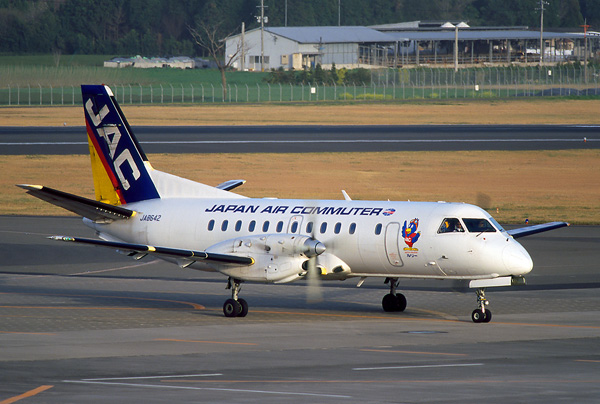Daughters
In 1983 Toa Domestic Airlines and the state jointly founded JAC - Japan Air Commuter (Nihon Air Commuter , the English words were not translated in the name), with Toa holding 60% of the shares. The circle had been completed, after a steady decrease in the number of companies due to mergers this time a new one was created. Moreover, this one went back to the roots of TDA: regional transport. In its liveries JAC maintained a similar look to TDA and JAS. At first the scheme featuring the red and green band was combined with 'Japan Air Commuter' titling on the fuselage and the characters 'JAC' big in white on the tailfin. Later on the fuselages were painted all white and had the English titles without any ornamentation on them. The tails received a simplified Airbus Rainbow striping (blue-red-yellow) with 'JAC' written in the blue part. Finally, a cartoon-like bird was added, the one JAC adopted as its mascot.
JAC started out with a very modest fleet by the way, consisting of three Do228-200s acquired from the factory: JA8835 (8007) joined JAC on September 13, 1983, JA8836 (8019) did so on November 10, 1983 and JA8866 (8124) four days later. All three went to Nishinihon Iryo Service on October 27, 1995. It was not before February 1992 that reinforcement of the fleet arrived in the shape of the Saab 340. Over the years, a total of twelve have flown for Nihon Air Commuter . Simultaneously, most of the YS-11s were transferred from the mother company to the commuter division around 1993 and the rest of them was soon to leave to operators abroad. By early 2004, all of JAC's examples still served airfields in western Japan out of Kagoshima, making the company the only civil operator of the type left around, and the biggest in the world. Additionally, the Japanese government and armed forces do have quite a fleet of operational YS-11s of their own.
Two more subsidiaries of JAS have been founded after its transformation from TDA and we are mentioning of them here because of several similarities: HAC - Hokkaido Air System . The name (once more not translated) and acronym (once more serving as the logo) are a kind of mix of those used by JAC and JAS. On the airplanes these are the only differences from those belonging to JAC, the colour schemes are identical. Hokkaido Air System was brought to life on September 30, 1997, with JAS and the northern island's government taking a share of 51% and 49% respectively. Another reason to mention this firm at this moment is the flying part of its assets, consisting of three Saab 340s and thus fitting seamlessly to the other commuter branch.

[1] Noted in new JAL Group colours with own titles.
Saab 340B |
|||
| 281 | JA8886 | 06feb92 | JAC |
| 308 | JA8887 | 21aug92 | JAC |
| 331 | JA8888 | 08feb93 | JAC |
| 355 | JA8703 | 18jan94 | JAC |
| 361 | JA8704 | 02jan95-26jan95 | JAS - to JAC |
| 365 | JA8642 | 09dec94-16dec94 | JAS - to JAC |
| 368 | JA8649 | 28jun95 | JAC [1] jun03 |
| 378 | JA8900 | 03jan96 | JAC |
| 399 | JA8594 | 02jul96 | JAC |
| 419 | JA001C | 16jun97-03jul97 | JAS - to JAC |
| 432 | JA01HC | 03feb98 | HAC [1] mar04 |
| 440 | JA02HC | 04jun98-23jun98 | JAC - to HAC |
| 458 | JA03HC | 30aug99 | HAC [1] 28nov03 |
| 459 | JA002C | 13sep99 | JAC [1] jun03 |